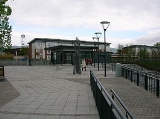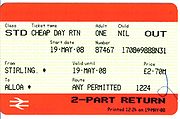
Alloa railway station
Encyclopedia
- This article refers to the former North British RailwayNorth British RailwayThe North British Railway was a Scottish railway company that was absorbed into the London and North Eastern Railway at the Grouping in 1923.-History:...
station, and its British Railways successor. For the former Alloa RailwayAlloa RailwayThe Alloa Railway was authorised on 11 August 1879 to link the South Alloa Branch of the Scottish Central Railway to the Stirling and Dunfermline Railway.- History :...
station see Alloa (Alloa Railway) railway station.
Alloa railway station is a railway station
Train station
A train station, also called a railroad station or railway station and often shortened to just station,"Station" is commonly understood to mean "train station" unless otherwise qualified. This is evident from dictionary entries e.g...
in the town of Alloa
Alloa
Alloa is a town and former burgh in Clackmannanshire, set in the Central Lowlands of Scotland. It lies on on the north bank of the Firth of Forth close to the foot of the Ochil Hills, east of Stirling and north of Falkirk....
, Clackmannanshire
Clackmannanshire
Clackmannanshire, often abbreviated to Clacks is a local government council area in Scotland, and a lieutenancy area, bordering Perth and Kinross, Stirling and Fife.As Scotland's smallest historic county, it is often nicknamed 'The Wee County'....
, Scotland
Scotland
Scotland is a country that is part of the United Kingdom. Occupying the northern third of the island of Great Britain, it shares a border with England to the south and is bounded by the North Sea to the east, the Atlantic Ocean to the north and west, and the North Channel and Irish Sea to the...
, which was re-opened on Monday, 19 May 2008.
History
The original Alloa station was opened by the Stirling and Dunfermline RailwayStirling and Dunfermline Railway
The Stirling and Dunfermline Railway was a railway in Clackmannanshire and Fife, Scotland connecting the stations in Stirling and Dunfermline. It had a branch line from Alloa to Tillicoultry.-Closure:...
on 28 August 1850 when the line was opened. Passengers to Stirling were transported via ferry along the River Forth
River Forth
The River Forth , long, is the major river draining the eastern part of the central belt of Scotland.The Forth rises in Loch Ard in the Trossachs, a mountainous area some west of Stirling...
to Stirling
Stirling
Stirling is a city and former ancient burgh in Scotland, and is at the heart of the wider Stirling council area. The city is clustered around a large fortress and medieval old-town beside the River Forth...
. This situation continued until the line to Stirling was opened on 1 July 1852, however the terminus was to the north of the Forth. On 1 July 1853, the bridge across the Forth was opened and the line extended to the Scottish Central Railway
Scottish Central Railway
The Scottish Central Railway was formed in 1845 to link the Caledonian Railway near Castlecary to the Scottish Midland Junction Railway at Perth...
station.
As the Stirling and Dunfermline Railway was part of the North British Railway
North British Railway
The North British Railway was a Scottish railway company that was absorbed into the London and North Eastern Railway at the Grouping in 1923.-History:...
, the station was absorbed into the London and North Eastern Railway
London and North Eastern Railway
The London and North Eastern Railway was the second-largest of the "Big Four" railway companies created by the Railways Act 1921 in Britain...
during the Grouping
Railways Act 1921
The Railways Act 1921, also known as the Grouping Act, was an enactment by the British government of David Lloyd George intended to stem the losses being made by many of the country's 120 railway companies, move the railways away from internal competition, and to retain some of the benefits which...
of 1923. The station then passed on to the Scottish Region of British Railways
Scottish Region of British Railways
The Scottish Region was one of the six regions created on British Railways and consisted of ex-London, Midland and Scottish Railway and ex-London and North Eastern Railway lines in Scotland...
on nationalisation in 1948. It was closed by the British Railways Board
British Railways Board
The British Railways Board was a nationalised industry in the United Kingdom that existed from 1962 to 2001. From its foundation until 1997, it was responsible for most railway services in Great Britain, trading under the brand names British Railways and, from 1965, British Rail...
in 1968.
Route information
Services
The current service gives an hourly train to Stirling and Glasgow seven days a week, with an additional peak hour commuter service to Edinburgh running six days a week. The journey time to Stirling is 12–14 minutes. Services are usually operated by a Class 170 or a Class 158.Closure
During the mid 1960s the lines in West Fife around Alloa were progressively closed. Cambus and Alloa both closed on 7 October 1968. Freight services continued until 1970.Following the full closure of Alloa station, a leisure centre was built on the site.
Re-siting

Under Scottish Executive funding, the line between Stirling
Stirling
Stirling is a city and former ancient burgh in Scotland, and is at the heart of the wider Stirling council area. The city is clustered around a large fortress and medieval old-town beside the River Forth...
and Alloa was reopened to both passenger and freight traffic, with a key benefit being a reduction in congestion on the Forth Railway Bridge. Construction work started in 2005, with track laying commencing at the end of September 2006. It was originally projected that the station would reopen to passenger traffic in the Summer of 2007, but this date was then put back to allow for the upgrading of a level crossing
Level crossing
A level crossing occurs where a railway line is intersected by a road or path onone level, without recourse to a bridge or tunnel. It is a type of at-grade intersection. The term also applies when a light rail line with separate right-of-way or reserved track crosses a road in the same fashion...
.
The official opening took place on Thursday, 15 May 2008.
Passenger use of the new railway station has greatly exceeded forecasts, and since re-opening the service has been improved by increasing evening and Sunday frequencies from two-hourly to hourly, and by adding the peak hour service to Edinburgh in 2009. In its first year the station was used by 400,000 passengers, against a forecast of 155,000.

